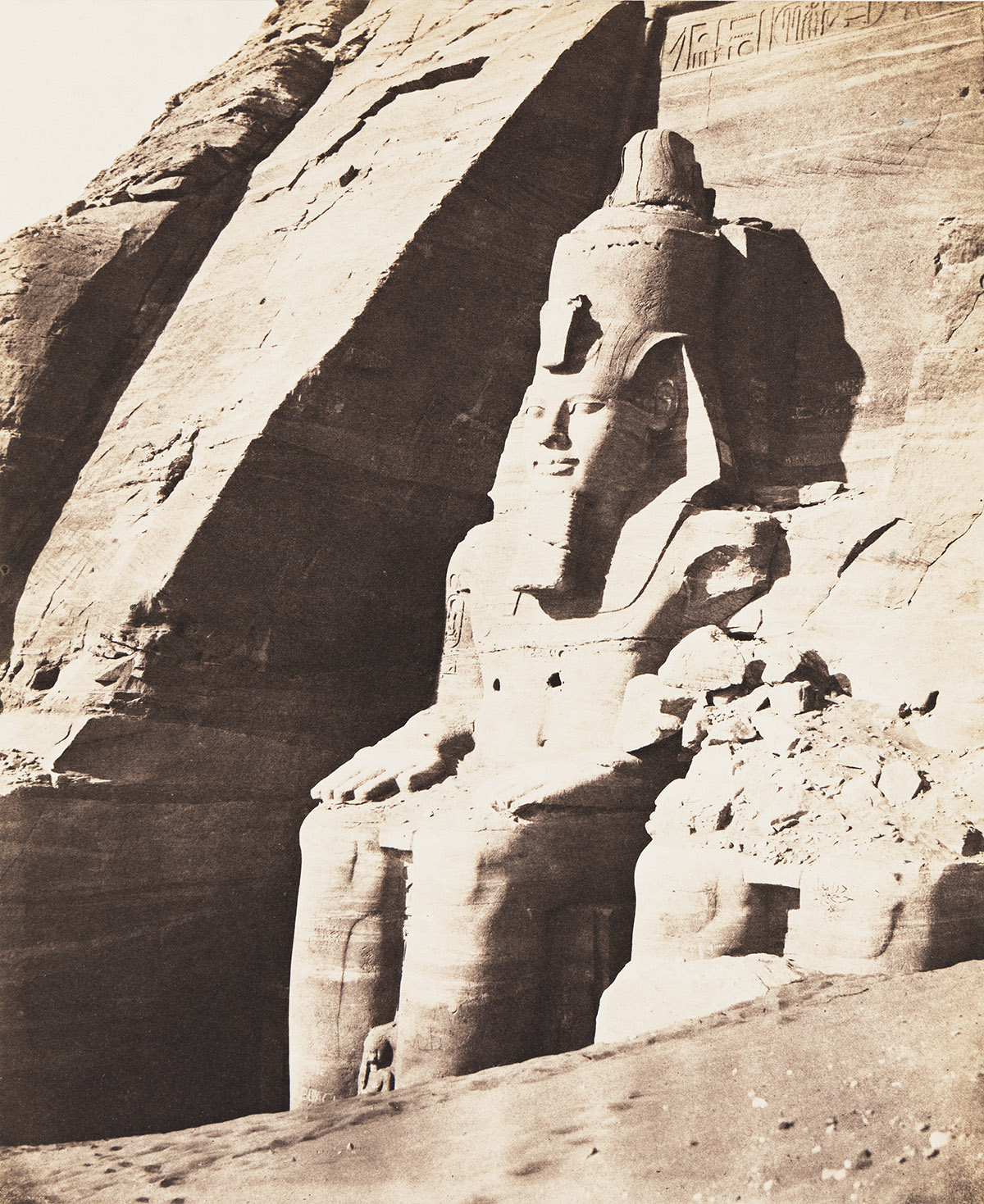Sale 2684 - Lot 20
Unsold
Estimate: $ 30,000 - $ 45,000
FÉLIX TEYNARD (1817-1892)
Colossal Statues Seen from Three-Quarters View, the Temple of Ramese at Abu Simbel. 1851-52.
Salt print from a waxed paper negative, the image measuring 12x9¾ inches (30.5x24.7 cm.), the mount 20⅜x15¾ inches (51.7x40 cm.), with the title in pencil in an unknown hand on mount recto.
This print was likely made prior to the published sets with lithograph credits and titles.
Provenance
Robert Hershkowitz, London; Christie's, New York, October 5, 2015; Private Collector, Asia; Paul Hertzmann; a California Collection
In 1851 civil engineer Félix Teynard embarked on a trip to photograph the great archaeological sites along the Nile. Napoleon's forays into Egypt had triggered a wide curiosity in France regarding the culture of ancient Egypt, and Teynard himself acknowledged the role this played in his own project, traveling there purposefully to make a photographic record to accompany Description de l'Egypte, the lavish publication issued by Napoleon between 1809 and 1829. Teynard understood that photography could accomplish what the engravings could not, conveying both the light, the sublime physical structures, their relationship to each other, and their state of restoration or destruction.
Teynard was not the first photographer to make this journey-pioneer daguerreotypist Girault de Prangay had made his own remarkable survey a decade earlier, though it was never published, and, crucially, Maxime du Camp had undertaken his photographic project in 1849-51, to be published by Blanquart-Evrard in 1852.
But Teynard's Egypte et Nubie Sites et Monuments les plus intéréssants pour l'Etude de l'Art et de l'Histoire was a triumph of scholarly observation that was also a stunning demonstration of technical and artistic mastery of the still-young medium of photography. He traveled more than 100 miles up the Nile River, then an isolated and remote region with his cumbersome, heavy equipment, and produced an astonishing record of what he found, making the most comprehensive survey to date of the Nile Valley. Teynard's dramatic images were rendered as finely modulated salt prints of a distinctive pinkish hue. The present print, depicting the Colossal Statue of Abu Simbel with the small figure of the Queen between its legs, is a magnificent example.
Teynard's aesthetically impressive and historically important portfolio included 160 prints as well as accompanying text. It was published in 32 installments of five plates, beginning in 1853. A complete edition was published in 1858 at the high cost of almost a thousand Francs. This, and du Camp's slightly earlier publication, may account for the extreme rarity of these prints today. Today fewer than a dozen copies survive.
Reproduced
Haws, Félix Teynard: Calotypes of Egypt – A Catalogue Raisonné (Hans P. Kraus Jr. Inc, New York, Robert Hershkowitz Ltd, London, Weston Gallery Inc., Carmel, 1992), p. 101, pl. 155
Colossal Statues Seen from Three-Quarters View, the Temple of Ramese at Abu Simbel. 1851-52.
Salt print from a waxed paper negative, the image measuring 12x9¾ inches (30.5x24.7 cm.), the mount 20⅜x15¾ inches (51.7x40 cm.), with the title in pencil in an unknown hand on mount recto.
This print was likely made prior to the published sets with lithograph credits and titles.
Provenance
Robert Hershkowitz, London; Christie's, New York, October 5, 2015; Private Collector, Asia; Paul Hertzmann; a California Collection
In 1851 civil engineer Félix Teynard embarked on a trip to photograph the great archaeological sites along the Nile. Napoleon's forays into Egypt had triggered a wide curiosity in France regarding the culture of ancient Egypt, and Teynard himself acknowledged the role this played in his own project, traveling there purposefully to make a photographic record to accompany Description de l'Egypte, the lavish publication issued by Napoleon between 1809 and 1829. Teynard understood that photography could accomplish what the engravings could not, conveying both the light, the sublime physical structures, their relationship to each other, and their state of restoration or destruction.
Teynard was not the first photographer to make this journey-pioneer daguerreotypist Girault de Prangay had made his own remarkable survey a decade earlier, though it was never published, and, crucially, Maxime du Camp had undertaken his photographic project in 1849-51, to be published by Blanquart-Evrard in 1852.
But Teynard's Egypte et Nubie Sites et Monuments les plus intéréssants pour l'Etude de l'Art et de l'Histoire was a triumph of scholarly observation that was also a stunning demonstration of technical and artistic mastery of the still-young medium of photography. He traveled more than 100 miles up the Nile River, then an isolated and remote region with his cumbersome, heavy equipment, and produced an astonishing record of what he found, making the most comprehensive survey to date of the Nile Valley. Teynard's dramatic images were rendered as finely modulated salt prints of a distinctive pinkish hue. The present print, depicting the Colossal Statue of Abu Simbel with the small figure of the Queen between its legs, is a magnificent example.
Teynard's aesthetically impressive and historically important portfolio included 160 prints as well as accompanying text. It was published in 32 installments of five plates, beginning in 1853. A complete edition was published in 1858 at the high cost of almost a thousand Francs. This, and du Camp's slightly earlier publication, may account for the extreme rarity of these prints today. Today fewer than a dozen copies survive.
Reproduced
Haws, Félix Teynard: Calotypes of Egypt – A Catalogue Raisonné (Hans P. Kraus Jr. Inc, New York, Robert Hershkowitz Ltd, London, Weston Gallery Inc., Carmel, 1992), p. 101, pl. 155

Exhibition Hours
Exhibition Hours
Aliquam vulputate ornare congue. Vestibulum maximus, libero in placerat faucibus, risus nisl molestie massa, ut maximus metus lectus vel lorem.


